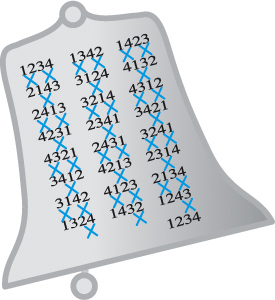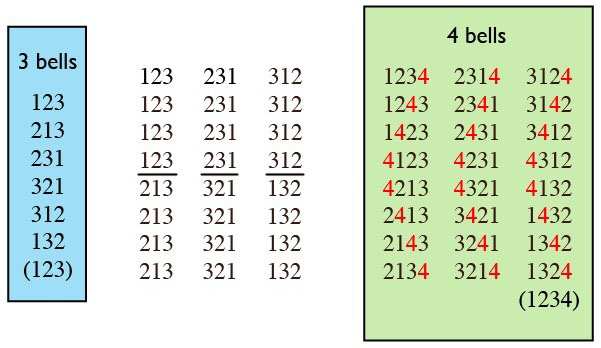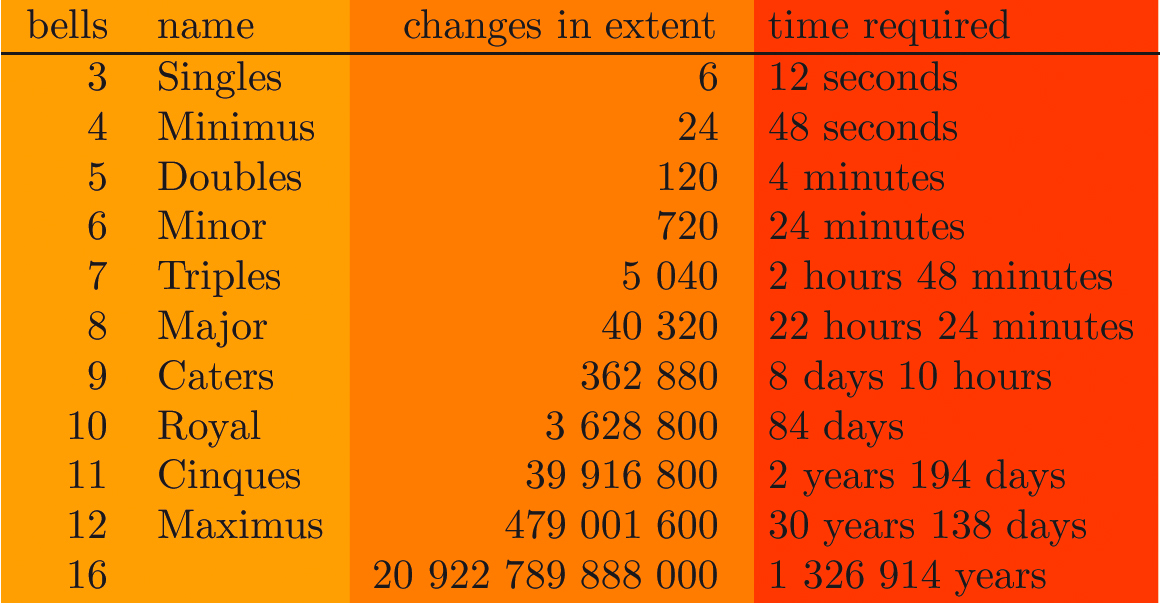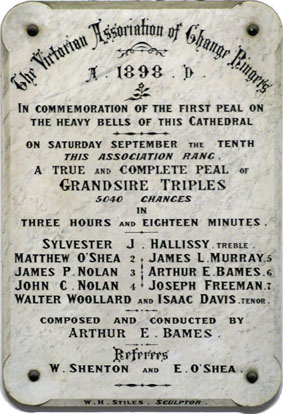
Ringing the changes
Do you prefer your maths in exotic locations? Then perhaps you should join a band of bell ringers, engaged in the grand old practice of ringing the changes. You could then employ your art in churches throughout (mainly) the English speaking world. But what does bell ringing have to do with maths? As we'll explain, a lot!
The rules of the game
Let's begin by paying a virtual visit to the bell ringers of St Paul's Cathedral in Melbourne, Australia.
St Paul's has twelve main bells, tuned in the key of C# major. The smallest, which we can label bell 1, sounds the highest note, with the largest, bell 12, sounding the lowest. Changes can be rung using any number of bells. So, we'll simplify things and begin with just bells 1 to 4.
A change is what mathematicians refer to as a permutation, the ringing of each of the four bells exactly once. For example, 3214 refers to the change of ringing bell 3, then bell 2, bell 1 and finally bell 4. To ring the changes means to ring a sequence of changes, whilst obeying three mathematical rules:
- The sequence starts and ends with the change 1234.
- Except for 1234 as the first and last changes, no change is repeated.
- From one change to the next, any bell can move by at most one position in its order of ringing.

The Plain Bob ringing of all permutations of four bells.
Here we first move down the left column, then the middle column and finally the right column. You can check that the third rule is obeyed — from one change to the next a bell either remains where it is, or it swaps places with an adjacent bell, as indicated by the crosses.
Here are a few facts to give you a sense of real bell ringing. To ring one change takes roughly two seconds, about the time for a large bell to complete its natural swing. When bell ringers really go wild, they may ring a sequence of 5,000 changes or more (known as a peal), resulting in several hours of bellish amusement for the neighbours. Also, by convention, bell ringers are not permitted any memory aids such as sheet music. Nor may they be relieved by another bell ringer in order to, well, "relieve" themselves. This means that a serious bell ringer must effectively recite a sequence of several thousand numbers, one every two seconds, and to translate this sequence into perfect bell ringing. It can take a bell ringer several months to master ringing a single bell on their own, and years before they can dream of performing marathon bell ringing as a member of a team.
Ringing lots of changes
When ringing bells, one of the grand goals is to ring a sequence that includes every possible change. This is known as an extent. An extent on four bells contains all 1×2×3×4=24 possible changes, as is the case for Plain Bob. (Traditionally, the first occurrence of the change 1234 is not included in the count). In general, an extent on n bells consists of all 1×2×3×...×n possible changes.
If we have a large number of bells, it is not obvious how to construct an extent that obeys the bell ringing rules. To see one way that this can be done, consider the diagram below. It illustrates a clever method for transforming an extent on three bells into an extent on four bells. Each of the changes in the 3-bell extent is written four times, and then a 4 is inserted in every change, so that the new digits oscillate between right and left as indicated. But then, the very same scheme allows us to transform our 4-bell extent into a 5-bell extent, and then into a 6-bell extent, and so on, up to as many bells as we wish.

Creating a 4-bell extent from a 3-bell extent.
The following table indicates the numbers of changes in extents on varying numbers of bells, and the approximate time needed to ring them. The names are those commonly used by bell ringers to denote the various sequences. For example, our 4-bell extent above is known as Plain Bob Minimus. It is also possible to ring Plain Bob Doubles (on five bells), Plain Bob Minor (on six bells) and so on, each with the same basic structure as Plain Bob Minimus. Other sequences that you may come across carry such quintessentially English names as Reverse Canterbury Pleasure Place Doubles, Grandsire Triples, and Cambridge Surprise Major.

With one ringer per church bell, probably the largest extent that is humanly possible is an extent on eight bells. This has apparently been achieved only once, at the Loughborough Bell Foundry in 1963. The ringing began at 6.52am on July 27, and finished at 12.50am on July 28, after 40,320 changes and 17 hours 58 minutes of continuous ringing, and an unknown number of complaints to the police.
Of course, to ring such an enormous sequence of changes is astonishingly difficult, both physically and mentally. So how do they do it? The main trick is to use sequences that are as easy as possible to remember. Taking a closer look at Plain Bob, you can see that each column is generated from the change at the top by a simple knitting pattern of swaps. Then, at the end of the first and second columns, the last two bells are swapped, linking the three columns together. Based on this simple algorithm, it is very easy to reconstruct the whole sequence from scratch. Try it!
Also, as a bell ringer you are only in charge of a single bell and you need only remember how this one bell moves. For example, if you were in charge of bell 4 in the 4-bell extent constructed above, all you would have to remember is to constantly move left and right. In Plain Bob Minimus, bell 1 also moves in this very simple manner.
Finally, as we have seen, Plain Bob Minimus splits into three similar pieces, with special transitions between them. Most practical ringing sequences have a similar structure. Then, all the bell ringers have to remember is how to ring one of these basic pieces, together with the exceptional transitions. The conductor, a particularly gifted bell ringer, also memorises the transitions between the individual parts and alerts his fellow bell ringers whenever one of the transitions is approaching.
Grouping, flipping and cycling the changes
Permutations and collections of permutations have central roles in many branches of mathematics. In particular group theory, the area of mathematics concerned with symmetries, is loaded with permutations. And, probably the earliest examples of serious group theory in action are the highly structured bell ringing sequences developed in the early 17th century. In particular, the structural elements that simplify the memorisation and execution of a ringing sequence often have very natural mathematical interpretations. Let's demonstrate this in the case of Plain Bob.
A symmetry of a shape can be thought of as a way of bringing that shape into coincidence with itself. The following diagram illustrates how the eight symmetries of a square correspond to the eight permutations in the first column of Plain Bob Minimus. It also shows that the transitions between these permutations simply amount to flips of the square. (The knitting pattern of the Plain Bob ringing sequence on n bells similarly corresponds to the flipping sequences of a regular n-sided polygon).

Plain Bob = flipping the changes.
Collected together, the symmetries of the square form a mathematical structure called the symmetry group of the square. The separation of Plain Bob Minimus into three columns then has an associated mathematical interpretation: it corresponds to the partition of the general symmetric group on four elements into the cosets of that group. Perhaps a bit arcane, but pretty cool if you're familiar with group theory.
Here is another mathematically insightful way of thinking about extents and how to construct them. Think of the permutations as the vertices of a graph. Two vertices are connected by an edge if there is a permitted transition (according to bell ringers) that transforms one change into the other. The complete graph for four bells is shown in the following diagram. Note that there are four different types of transitions between permutations, corresponding to four different edge colours. Then an extent is simply a complete tour of this graph, visiting each of the vertices exactly once, and returning to the beginning vertex. Such tours are called Hamiltonian cycles. They play a very important role in the theory of graphs.

The 4-bell extents correspond to the Hamiltonian cycles in this graph.
Actually, every Hamiltonian cycle in such a graph corresponds to two different extents, since a cycle can be traversed in two directions — ringing an extent backwards gives a new extent. Below is the Hamiltonian cycle corresponding to Plain Bob Minimus. In total, there are 10,792 different Minimus extents that can be found in the above graph.

The Hamiltonian cycle corresponding to Plain Bob Minimus.
Why the Noise?
But how on Earth did anybody dream up this complicated, mathematical manner of ringing bells? Why not just play tunes? And how have they been getting away with doing so for centuries? After all, many people really do complain of the "noise". And together the bells do form a musical instrument; striking the bells with hammers, one could actually play real melodies.
The problem is that if you want to ring the bells by swinging them, which sounds a lot more impressive and carries the sound much further, ringing tunes is not really an option. We are talking about very large bells (upwards of 1.5 tonnes in the case of St Paul's). Once set in motion it is difficult for a bell ringer to much vary the interval at which such a monster bell will ring. This is the mechanical constraint that explains the third rule of bell ringing, and motivated bell ringers to invent mathematically perfect bell ringing.
Originally, change ringing was a competitive sport, with bands of brawny ringers competing against each other. These bands were often at odds with the Church itself, what with their less than divine inspiration. The exercise, as it was called, had as much to do with penalising each other drinks for mess-ups as it did with actually ringing the bells.
Bell ringing has come a long way and has mellowed since its bloodsport origins. However, if you are interested in maths and serious mind games, and maybe some ale, do visit one of 6000 churches and secular buildings where bell ringing is practised. See the websites of The Central Council of Church Bell Ringers and The Australian and New Zealand Association of Bellringers for more information.
Even if you are the only person in a 1,000 mile radius keen on bell ringing, you needn't despair. If you play any instrument you can simply "play the changes". Or, if you desire a computer program to do it all for you, check out Kees van den Doel's bell ringing applet, or Theo van Soest's Method Writer (both programs are free). On the other hand, if you a looking for a real challenge, you can try "juggling the changes":
Acknowledgements
We'd like to thank the bell ringers of St Paul's Cathedral (and St Patrick's Cathedral) in Melbourne, Australia, for all their help with the video clips. Very special thanks to Helen Pettet (the lady with the yellow top in the movie clips), for hosting our visits and for carefully proofreading earlier drafts of this article. Of course, any remaining errors (and all the cheap shots) are totally of our making.Endnotes
1. The change corresponding to ringing the bells in order 1234 is called rounds. Bell ringers will initially ring rounds a number of times, to warm up before launching into a proper ringing sequence. In record attempts the first change that is counted is the first change rung that is different from rounds. On the other hand, for a mathematical analysis of ringing sequences it makes more sense to count the last of the rounds in the warm up as the first change in the sequence. This is what we have implicitly done in this article − all our ringing sequences start with rounds. A minor difference, but probably worth pointing out.
2. The most common challenge that real bell ringers set for themselves is to ring a peal, comprising at least 5,000 changes. Very often the target is 5,040 changes, the number of changes in an extent on seven bells.

3. The strict rules that we've referred to in this article are not always adhered to. For example, the rule that ringers cannot share duty on a bell was clearly not followed in the first marathon ringing at St Paul's in Melbourne, Australia, in 1898: the commemorative plaque notes that two bell ringers were in charge of the largest bell. One might chalk that up to the convict mentality. However, in 1761 in England there was a 40,320 change extent on eight bells, also involving such cooperation: fourteen bell ringers shared the bells in that marathon.
4. The longest sequence rung on handbells consisted of 72,000 changes on six bells, performed by three bell ringers operating two bells each. This sequence was comprised of an extent of 720 changes rung one hundred times. It was performed only two years ago and took just over 24 hours of continuous ringing. Note that another of our rules was broken during this ringing, since each change was repeated one hundred times.
About the authors

Burkard Polster and Marty Ross are Australia's tag team of mathematics. They write the Maths Masters column for the The Age newspaper in Melbourne. For many years they have been delivering the mathematics lecture series at the Melbourne Museum, visiting schools and touring the countryside with their Mathematical Mystery Tour. Burkard and Marty are both lecturing mathematics, Burkard at Monash University and Marty at the University of Melbourne.
Check out what else Burkard and Marty are up to at www.QEDcat.com.
Comments
Anonymous
''Note that another of our rules was broken during this ringing, since each change was repeated one hundred times.''
This doesn't actually break any of the rules of change ringing. When ringing on 6 bells or fewer, changes obviously have to be repeated to get to 5040 changes, so the rule is that no change must be repeated more than any other. The maximum number of times any one change can be repeated is the length of the peal divided by the number of changes in the extent on the number of bells you are ringing. So on 5 bells, you are allowed to ring a 5040 change peal by ringing every change exactly 42 times each, but if some changes were rung 43 times and others on 41, the peal would be disallowed.
Anonymous
Just incredible! Not only re-sequencing the order of the balls and such good juggling, but the striking was also excellent. Just amazing.
May I post your video on our local bellringing website (www.ilkleybellringing.org.uk)? I've just set it up, and your video would be a very welcome addition to a page about different aspects of ringing. I'd credit the video in whatever way you specify, of course.
Many thanks
Andrew Drury
Ilkley
England
Rachel
Andrew, we'll talk to the authors and get back to you.
Marianne
Dear Andrew,
The videos of the bell ringers were supplied by the authors of the article. You can get in touch with them via their website http://www.QEDcat.com/ to find out about permissions.
Anonymous
Thank you for this amazing article. Beautiful and rich connections. The juggling was especially impressive, I have a hard enough time playing the changes with four notes on a piano, much less keeping all of those throws in order. Quite an accomplishment!
Well done guys! Thanks for a great article.
Mike Naylor
Anonymous
Bells for math majors!
thanks for posting this
Anonymous
On the really heavy bells, it's often the case that two people ring it together. So the St Pauls peal may not have broken the rules.
Anonymous
Nonsense! There's no need for two ringers, however heavy the bell; take a look at Liverpool Cathedral's peal records (80 cwt, or about 4 tonnes).
Kevin Love
In this video of bellringing at Liverpool Cathedral, you can see two people ringing the tenor. See: https://www.youtube.com/watch?v=C8CVJjamKI4
Owen Toller
Sometimes it takes two people to "raise" a really heavy bell - that is, to get it from its "rest" position, mouth downwards, to its "up" position, ready to be pulled down so that it rings. When not in use, bells are generally left mouth downwards for safety reasons. Raising a bell takes quite a lot of work at the best of times - you have to give it a lot of angular momentum, a little at a time. But once it is raised, only one person actually rings it as part of the changes.